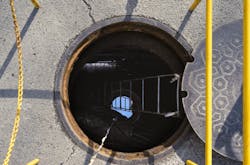Back to Basics Refresher: Clearing Up Confusion on Confined Entry Requirements
According to OSHA, a confined space is a space that is large enough and so configured that an employee can bodily enter it; has limited or restricted means for entry and exit; and is not designed for continuous employee occupancy. In 2015, OSHA issued a new standard for construction in confined spaces (Subpart AA of 29 CFR 1926). The new standard, per OSHA, “will help prevent construction workers from being hurt or killed by eliminating and isolating hazards in confined spaces at construction sites similar to the way workers in other industries are already protected.”
Certain misconceptions exist in the industry, however, that may lead some electrical professionals down the wrong path, such as what exactly is the difference between a "confined entry space" and a "permit required confined space." Over the years, EC&M has run several articles on this important topic. In an effort to cut through the confusion, we’ve packaged these articles together here in one place.
Mark Lamendola, an electrical industry consultant and one of our regular contributors to EC&M, maintains there are five assumptions you should never make before entering a confined entry space, that is if you want to walk out of that same space at the end of the job.
- If the permit was good yesterday, it’s good today.” Your confined entry permit is good only for the time stated on the permit. If the permit has expired, don’t enter without a new permit. And remember, this is your permit.
- “The permit applies to everything beyond this door.” Read carefully what area the permit describes. It might not even cover the area where you need to work.
- “As long as I check the important items, I’ll be fine.” If it’s on the permit, it’s important. Personally make sure every condition of the permit is satisfied.
- “Whoever wrote the permit thought of all hazards.” A confined entry permit addresses only specific types of hazards. It doesn’t, for example, address electrical hazards.
- “I’ll be quick.” Famous last words.
Let’s get back to basics and look at some of the most relative articles we've run on this subject (click on individual article links below):
